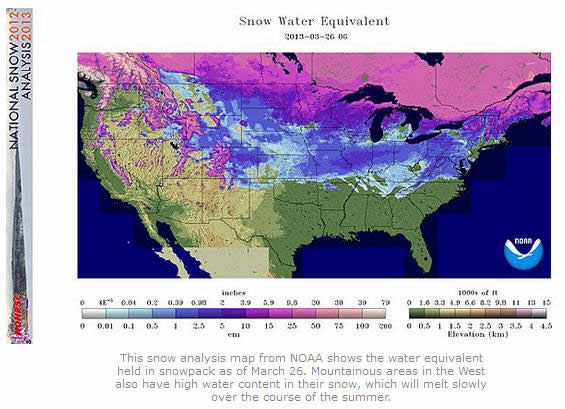
State College, PA-(ENEWSPF)- AccuWeather.com reports while spring is officially here, many parts of the United States still feel like they are stuck in winter’s grasp. Snow has continued to fall across parts of the Plains, Midwest, mid-Atlantic and the Northeast. However, as temperatures rise in the coming weeks, that snow will turn to water, and that will cause problems for rivers and streams across the country.
These late-winter snowstorms contain more water than storms a few months prior. Wet snow, which holds more water, is more likely to form during end-of-season storms. On average, for every 5 inches of wet snow you get 1 inch of water, compared to an average of half an inch of water for 5 inches of powdery snow. For some areas in the Northeast and the Plains, there are over 6 inches of water stored in snowpack.
"If you get a warm rain to come through in the spring bringing 2 inches of water, and it melts the snowpack and releases 6 inches of water there, you could see 8 extra inches of water that rivers and streams have to handle," said AccuWeather Expert Senior Meteorologist Alex Sosnowski. "You also have to worry about the impacts of ice jams on those waterways."
Another factor in spring flooding is the ground temperature. If some ground areas are still frozen, it won’t be able to soak up flood waters. Sosnowski warns that this time of year it’s possible to see a snowstorm come in and pile on more wet snow, then a warmer storm come through right after to cause rapid melting.
AccuWeather meteorologist Jim Andrews cites January of 1996 as an example of this kind of flooding. About 2 to 3 feet of snow quickly turned into 2 to 4 inches of water from a rain storm. In the spring, he says, conditions are even more troublesome, as higher dew points add to moisture.
Andrews says that the Red River Valley in the Dakotas should be particularly watched. The low-gradient river, which has the rare quality of flowing north, will take time to flood. While this can be good news for people who may need to move out of its way, it also means that it will take a long time to recede. The flat landscape leaves nothing to try to stop the water once it crests over the river banks. New England’s Connecticut River is another area Andrews warns may see some high flooding this spring, as there are high water levels in Northeastern snow.
By Samantha-Rae Tuthill, Staff Writer for AccuWeather.com








